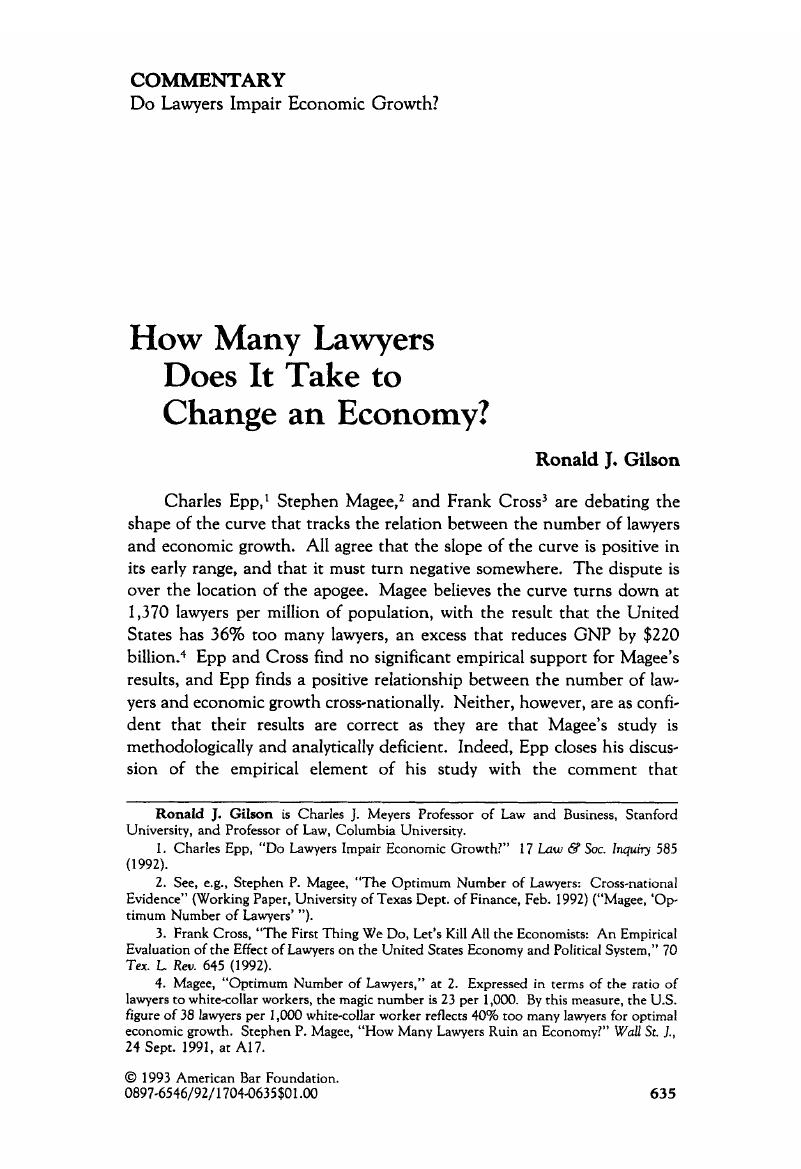Article contents
How Many Lawyers Does It Take to Change an Economy?
Published online by Cambridge University Press: 27 December 2018
Abstract

- Type
- Commentary
- Information
- Copyright
- Copyright © American Bar Foundation, 1992
References
1 Charles Epp, “DO Lawyers Impair Economic Growth?” 17 Law & Soc. Inquiry 585(1992).CrossRefGoogle Scholar
2 See, e.g., Magee, Stephen P., “The Optimum Number of Lawyers: Cross-national Evidence” (Working Paper, University of Texas Dept. of Finance, Feb. 1992) (“Magee, ‘Optimum Number of Lawyers' “).Google Scholar
3 Frank Cross, “The First Thing We Do, Let's Kill All the Economists: An Empirical Evaluation of the Effect of Lawyers on the United States Economy and Political System,” 70 Tex. L Rev. 645 (1992).Google Scholar
4 Magee, “Optimum Number of Lawyers,” at 2. Expressed in terms of the ratio of lawyers to white-collar workers, the magic number is 23 per 1,000. By this measure, the US. figure of 38 lawyers per 1,000 white-collar worker reflects 40% too many lawyers for optimal economic growth. Magee, Stephen P., “How Many Lawyers Ruin an Economy?”Wall St. J., 24 Sept. 1991, at A17.Google Scholar
5 Cross, 70 Tex. L Rev. at 674–78.Google Scholar
6 See Derek, Bok, “The President's Report to the Board of Overseers of Harvard University for 1981-82,”reprinted in 33 J. Legal Educ. 570 (1983); Akio Morita, “Do Companies Need Lawyers? Sony's Experiences in the United States,” 30 Japan Q. 2 (Jan.-Mar. 1983).Google Scholar
7 See Gilson, Ronald J., “Value Creation by Business Lawyers: Legal Skills and Asset Pricing,” 94 Yale L J. 239 (1984).Google Scholar
8 Id. at 256–93.Google Scholar
9 W. Carl Kester, “Governance, Contracting and Investments: Time Horizons” 19(Harvard Business School Working Paper No. 92–003 (1991)).Google Scholar
10 See Hashimoto, Masanori, “Bonus Payments, On-the-Job Training, and Lifetime Employment in Japan,” 87 J Pol Econ. 1086 (1979).Google Scholar
11 Gilson, 94 Yale L.J. at 311–12.Google Scholar
12 See Gilson, Ronald J. & Roe, Mark J., “Understanding the Japanese Keiretsu: Overlaps between Corporate Governance and Industrial Organization,” 103 Yak L.J. (forthcoming 1993); Masahiko Aoki, “Ex Post Monitoring by the Main Bank” (Center for Economic Policy Research Working Paper, Stanford University (Aug. 1992)); Masahiko Aoki & Paul Sheard, “The Role of Japanese Main Bank in the Corporate Governance Structure in Japan” (Center for Economic Policy Research Working Paper, Stanford University (Aug.1992)); John Garvey & Swan, Gerald T., “The Interaction between Financial and Employment Contracts: A Model of Japanese Corporate Governance” (Working Paper, Australian Graduate School of Management, University of New South Wales (1991)).Google Scholar
13 Roe, Mark J., “Difference in Corporate Governance in Germany, Japan and America,” 103 Yale L. J. (forthcoming 1993); id, “A Political Theory of American Corporate Finance,” 91 Col L Rev. 10 (1991).CrossRefGoogle Scholar
14 Porter, Michael E., “Capital Choices: Changing the Way America Invests in Industry,” 5 J. Appl Corp. Fin. 4 (Summer 1992); Gilson, 94 Yak LJ. at 311.CrossRefGoogle Scholar
15 I do not understand Epp and Cross to disagree with this point. Rather, they seem to have taken up the challenge of showing that Magee was wrong even on his own terms. “Trashing,” to use a currently popular term in the legal academy, is a worthwhile enterprise. However, it remains important to take the project from what isn't helpful to what would be.Google Scholar
16 See Marc Galanter & Joel Rodgers, “The Transformation of American Business Disputing? Some Preliminary Observations” (unpublished manuscript, University of Wisconsin, 1988); William Nelson, “Contract Litigation and the Elite Bar in New York City—1960–1980,” 39 Rev, Emory L. 413 (1990).Google Scholar
17 At a recent Ninth Circuit Judicial Conference, pillars of the legal establishment compared the conduct of commercial litigation to “freeway shootings,” in which elite firm litigators routinely took pot shots at each other as they pursued their cases. 1989 Ninth Circuit Judicial Conference, 11 July 1989.Google Scholar
18 See Gilson, Ronald J., “The Devolution of the Legal Profession,” 49 Md. L Rev. 869 (1990), on which this discussion draws. Familiar examples of strategic litigation include knee-jerk defensive litigation in response to hostile takeovers and trade secret suits brought against departing employees to chill their new business's access to venture capital. Id. at 875–76.Google Scholar
19 Steven Gillers & Norman Dorsen, Regulation of Lawyers: Problems of Law and Ethics 521 (quoting Root) (Boston: Little, Brown, 1991).Google Scholar
20 See Gilson, 49 Md L Rev. at 886–99.Google Scholar
21 Id. at 889–99.Google Scholar
22 See Gilson, Ronald J. & Mnookin, Robert H., “Cooperation and Cooperation in Litigation: Can Lawyers Dampen Conflict!” in Kenneth Arrow et al., eds., Barriers to Negotiated Resolution of Conflict (forthcoming 1993) (“Gilson & Mnookin, ‘Cooperation’“), on which this discussion draws.Google Scholar
23 Marc Galanter & Thomas Palay, Tournament of Lawyers: The Transformation of the Big Law Firm 46 (Chicago: University of Chicago Press, 1991).Google Scholar
24 For example, the internal structure of law firms, including especially promotion and compensation systems, takes on great importance. See Gilson & Mnookin, “Cooperation.”Google Scholar
- 1
- Cited by




